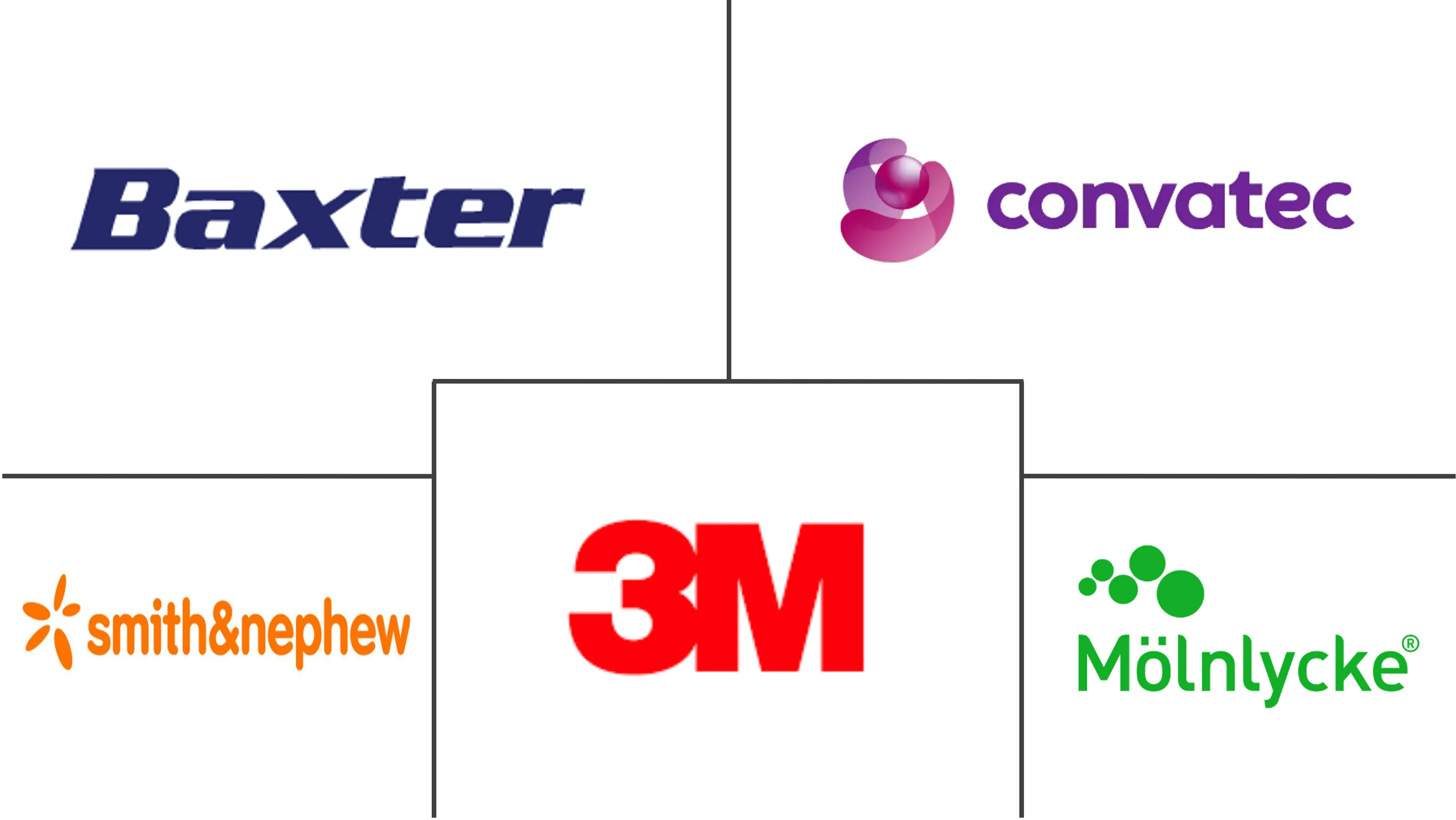Artificial Skin Market Size and Share
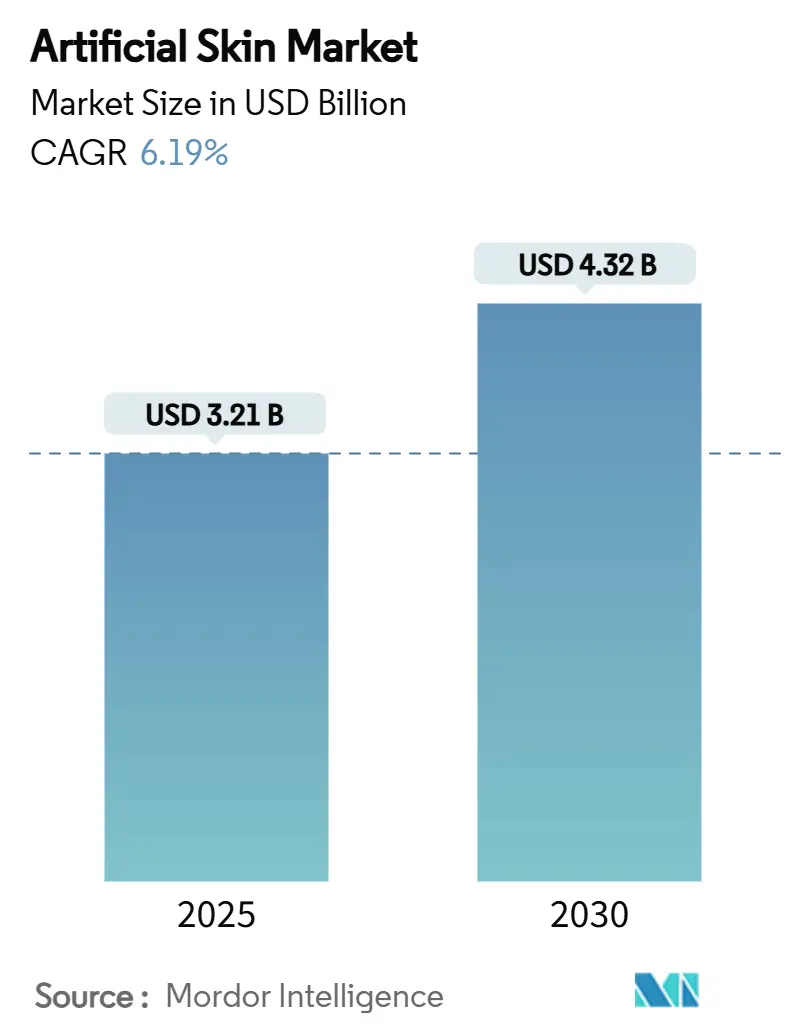
Artificial Skin Market Analysis by Mordor Intelligence
The artificial skin market size is valued at USD 3.21 billion in 2025 and is projected to reach USD 4.32 billion by 2030, advancing at a 6.19% CAGR during the forecast period. The upward path reflects synergistic gains from 3D bioprinting, smart biomaterials and AI-enabled electronic skin platforms that shorten healing times and widen clinical indications. Accelerated adoption in diabetic foot management, pressure-injury prevention and cosmetic resurfacing adds breadth to the demand base. Hospitals continue to procure premium composite scaffolds because they lower total cost of care by reducing graft failures and revision surgeries. Regulatory moves to flat-rate reimbursement are prompting manufacturers to automate production, expand bio-hybrid pipelines and cultivate efficiency partnerships with contract developers. Collaboration between research institutes and device firms speeds translation of laboratory breakthroughs into commercial products, helping preserve high single-digit growth even as pricing pressure intensifies.
Key Report Takeaways
- By product type, temporary solutions held 48.43% revenue share in 2024; composite/hybrid products are forecast to expand at an 8.65% CAGR to 2030.
- By replacement area, dermal substitutes accounted for 57.54% of the artificial skin market share in 2024, while full-thickness composites are advancing at an 8.88% CAGR through 2030.
- By material, natural collagen- and fibrin-based matrices captured 52.45% share of the artificial skin market size in 2024; bio-hybrid materials are set to grow at an 8.45% CAGR between 2025 and 2030.
- By application, acute wound treatment commanded 46.87% revenue in 2024; aesthetic indications are rising fastest at a 9.87% CAGR over the forecast horizon.
- By end-user, hospitals led with 62.45% of 2024 sales, whereas ambulatory surgical centers will post the highest 9.65% CAGR to 2030.
- By geography, North America retained 40.54% regional share in 2024; Asia-Pacific is projected to register the quickest 7.54% CAGR up to 2030.
Global Artificial Skin Market Trends and Insights
Driver Impact Analysis
| Driver | % Impact on CAGR Forecast | Geographic Relevance | Impact Timeline |
|---|---|---|---|
| Technological Innovations In Regenerative Medicine | +1.8% | North America & Europe | Medium term (2-4 years) |
| Increasing Incidence Of Chronic And Acute Skin Injuries | +1.5% | APAC & North America | Long term (≥ 4 years) |
| Rising Geriatric And Diabetic Population | +1.2% | APAC & North America | Long term (≥ 4 years) |
| Growing Demand For Advanced Wound Care Solutions | +1.0% | North America & Europe; expanding in APAC | Medium term (2-4 years) |
| Favorable Government Funding And Reimbursement Policies | +0.8% | North America & Europe | Short term (≤ 2 years) |
| Expanding Applications In Aesthetic And Robotic Fields | +0.6% | Global | Medium term (2-4 years) |
| Source: Mordor Intelligence | |||
Technological Innovations in Regenerative Medicine
AI-guided 3D bioprinting now fabricates patient-specific lattices that mimic native extracellular matrices at micron resolution[1]Korea Institute of Science and Technology, “Wireless-Sensor Artificial Skin Improves Healing,” EurekAlert.org, eurekalert.org. Korea Institute of Science and Technology researchers achieved a 120% uplift in healing rates with wireless sensor-embedded collagen-fibrin grafts, showing how smart materials merge tissue repair with biomechanical feedback. The University of Granada’s UGRSKIN platform has shown nearly 80% survival in major burn patients since 2016, validating living-cell constructs in severe trauma care. Precision software that tailors pore geometry and cytokine gradients personalizes therapy, supporting the premium segment of the artificial skin market. Hospitals reward these outcomes with formulary preference even while payer scrutiny on price intensifies.
Increasing Incidence of Chronic and Acute Skin Injuries
Diabetic foot ulcers affect more than 540 million people, driving annual global wound-management costs above USD 17 billion. Bioengineered fish-skin grafts closed 44% of diabetic ulcers within 16 weeks versus 26% under standard dressings, cutting amputation risk and inpatient days[2]NEJM Evidence Editorial Board, “Fish Skin Graft for Diabetic Ulcer Healing,” evidence.nejm.org. Rising traffic trauma and industrial burns in urban Asia amplify demand for fast-acting dermal matrices. Providers embrace evidence that early graft placement reduces infection rates and accelerates discharge, reinforcing growth across the artificial skin market.
Rising Geriatric and Diabetic Population
Medicare outlays on wound care were estimated as high as USD 96.8 billion in 2014, and the aging curve suggests higher allocations today. Older adults heal slowly because of reduced angiogenesis and collagen synthesis, while diabetes compounds the deficit with microvascular damage. Clinical trials show elderly diabetic patients experience shorter healing cycles and fewer readmissions when treated with bilayer skin substitutes. These predictable demographics underpin durable demand that encourages capacity expansion among material suppliers and contract manufacturers.
Growing Demand for Advanced Wound Care Solutions
Evidence-based practice guidelines now emphasize total cost reduction over unit price. Smith+Nephew recorded 6.5% revenue growth in its Advanced Wound Management division in Q3 2024 on strong uptake of GRAFIX PLUS, illustrating provider appetite for premium matrices that speed healing. Integration of digital bandages and remote analytics strengthens adherence, enhances clinician oversight and broadens clinical acceptance. Companies equipped with broad portfolios spanning dressings, scaffolds and biologics benefit from system-wide purchasing contracts that favor single-supplier efficiencies.
Restraints Impact Analysis
| Restraints Impact Analysis | (~) % Impact on CAGR Forecast | Geographic Relevance | Impact Timeline |
|---|---|---|---|
| High Treatment Costs And Budget Constraints | −1.5% | Emerging markets; global payers | Short term (≤ 2 years) |
| Stringent Multiregional Regulatory Frameworks | −1.2% | Global | Medium term (2-4 years) |
| Limited Vascularization And Integration Challenges | −1.0% | Global research hubs | Medium term (2-4 years) |
| Supply Chain Vulnerability For Biological Raw Materials | −0.9% | Global; heightened in APAC & Latin America | Short term (≤ 2 years) |
| Source: Mordor Intelligence | |||
High Treatment Costs and Budget Constraints
Extreme burn cases can exceed USD 9.8 million per patient when multiple grafts and ICU stays accumulate, prompting payer alarm. The Centers for Medicare & Medicaid Services has proposed cutting skin-substitute reimbursement to a flat USD 125.38 per square centimeter, a sharp shift from cost-plus formulas that previously encouraged premium pricing. Providers in low-income economies often delay adoption due to budget caps, limiting early-stage penetration of the artificial skin market. Manufacturers accelerate lean manufacturing, seek lower-cost collagen sources and partner with contract producers to preserve margins under price ceilings.
Stringent Multiregional Regulatory Frameworks
The European Union treats engineered skin as an Advanced Therapy Medicinal Product that requires centralized marketing approval, whereas the U.S. FDA may classify similar constructs as biologics, devices or combination products depending on cell content. China’s National Medical Products Administration is still refining tissue-engineering guidance, lengthening pre-market reviews for overseas entrants[3]NMPA, “Draft Guidelines on Tissue-Engineered Skin,” burnstrauma.com. Parallel dossiers, divergent clinical evidence demands and duplicated audits escalate development costs, especially for small companies, slowing global scale-up.
Segment Analysis
By Product Type: Temporary Solutions Drive Immediate Coverage
Temporary devices retained the largest slice of the artificial skin market in 2024 at 48.43% revenue because clinicians rely on them for prompt protection that controls exudate and lowers infection risk. Although non-cellular and cost-effective, these matrices require follow-up grafting when wounds penetrate the dermis. Composite and hybrid formats are now rising at an 8.65% CAGR as they combine a temporary epidermal layer with a durable dermal scaffold, reducing the number of surgical steps and shortening hospital stay. Hospitals value the integrated approach because it cuts donor-site morbidity and minimizes painful dressing changes, propelling steady uptake. Continuous R&D in electrospinning and melt-electrowriting is closing the cost gap with single-layer products, setting the stage for hybrid platforms to overtake incumbents later in the decade. The transition signals an inflection point for the artificial skin market as clinicians gravitate toward turnkey constructs that fuse immediate coverage with long-term regeneration.
Second-generation bilayer films exhibit tensile strength within 5% of native human skin and support vascular ingrowth as early as day 10 post-implantation. Automated roll-to-roll fabrication now produces homogenous pore structures that improve fluid drainage and cell migration. These technical gains will likely keep composite solutions on the reimbursement formularies of high-volume burn units even after pricing reform. Meanwhile, permanent full-take skin substitutes hold a niche in syndromic conditions yet grow steadily as living-cell sourcing and cold-chain logistics become more robust. The artificial skin industry therefore reflects a widening ladder of clinical sophistication rather than a binary shift, preserving choice across acuity levels.
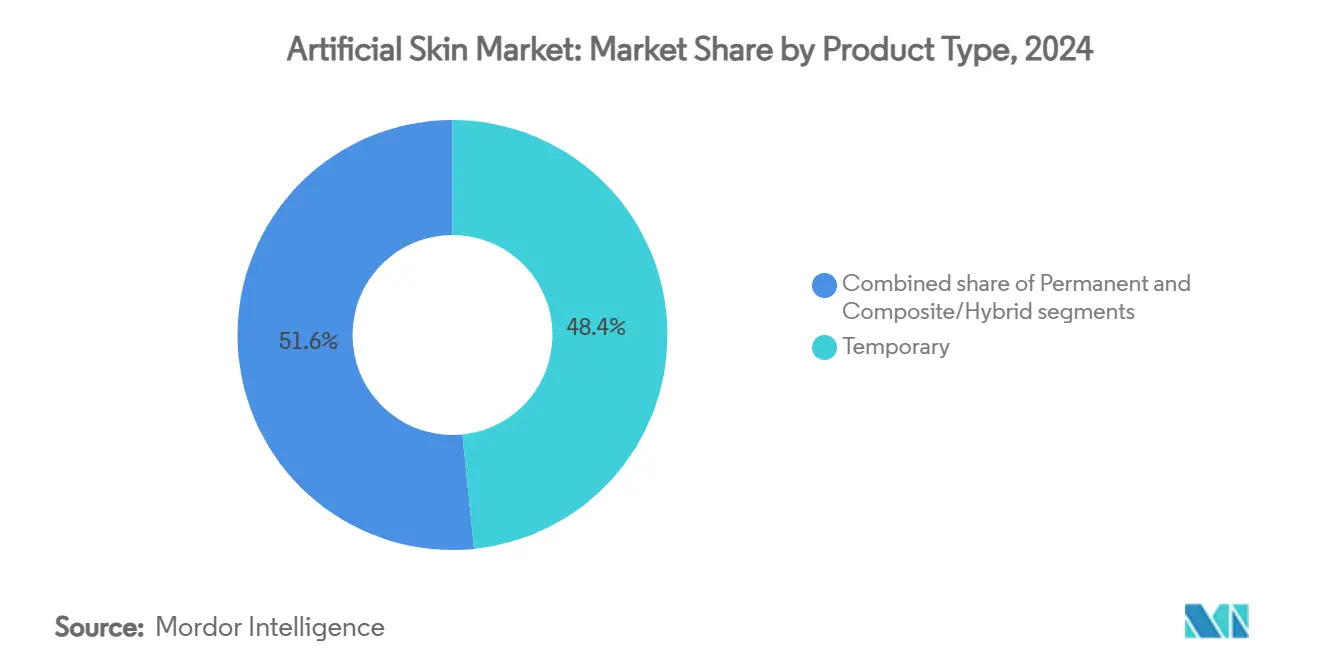
Note: Segment shares of all individual segments available upon report purchase
By Replacement Area: Dermal Dominance Shifts Toward Full Thickness
Dermal matrices generated 57.54% of 2024 revenue by recreating the collagen-rich layer that provides strength and elasticity. Surgeons have long targeted dermal repair first because epidermal autografts can later repopulate the surface. Full-thickness grafts are expanding fastest at an 8.88% CAGR now that bioreactors can co-culture keratinocytes and fibroblasts on the same scaffold without delamination. These all-in-one constructs reduce operative time by eliminating staged procedures, an efficiency prized in busy trauma centers. Early adopters report 27% smaller donor sites when using systems such as RECELL, easing morbidity and improving patient satisfaction. Epidermal-only films still serve cosmetic resurfacing and minor burns but face substitution risk as composite devices fall in price.
Looking ahead, academic consortia are experimenting with vascularized pre-assembled skin flaps that may further compress treatment timelines. If trials validate superior graft-take rates, reimbursement committees could endorse full-thickness options as first-line therapy for deep burns, accelerating their mix shift within the artificial skin market size hierarchy. However, regulatory data requirements remain high, so dermal substitutes will retain scale for the foreseeable future.
By Material: Natural Matrices Retain Lead While Bio-Hybrids Surge
Collagen and fibrin scaffolds held 52.45% revenue in 2024, supported by four decades of clinical familiarity and well-established supply chains from bovine, porcine and marine sources. Their intrinsic cell-binding domains aid angiogenesis, giving them an efficacy edge over purely synthetic polymers. Yet lot-to-lot variability and potential immunogenicity open doors for engineered bio-hybrids that splice peptide cues onto inert backbones. Bio-hybrid platforms are climbing at an 8.45% CAGR as they merge biological signaling with consistent mechanical behavior, simplifying sterilization and extending shelf life.
Researchers at Empa produced fish-gelatin hydrogels with lower immunogenic markers than mammalian collagen, pointing toward scalable and culturally acceptable raw materials. Synthetic polymers such as polycaprolactone cover niche indications requiring high tensile resilience, for example tendon-skin junction injuries. Over the forecast period, alliances between peptide chemistry start-ups and high-volume polymer extruders are likely to spur rapid cost declines, enabling bio-hybrids to capture share across chronic wound clinics and outpatient cosmetic centers within the artificial skin market.
By Application: Acute Wounds Dominate but Aesthetics Accelerate
Acute injuries including burns and trauma constituted 46.87% of 2024 turnover because immediate skin loss presents life-threatening fluid imbalance and infection risk. High-income countries maintain specialized burn units that standardize the use of bilayer grafts within 24 hours, supporting consistent purchasing volumes. Chronic wounds such as diabetic ulcers widen addressable demand yet often face fragmented reimbursement outside hospital systems. Cosmetic and aesthetic procedures grow fastest at a 9.87% CAGR as consumers seek scar-less healing and texture refinement. Printed skin models that replicate pigmentation and follicle orientation are under evaluation to replace animal testing in cosmetics, opening a non-clinical revenue stream.
The artificial skin market therefore evolves from a reactive lifesaving tool into a proactive lifestyle enhancer. Elective demand is less price-sensitive, allowing firms to offset margin pressure in institutional channels. Marketing strategies now pair clinical efficacy data with cosmetic outcome imagery to attract dermatology clinics and med-spa chains.
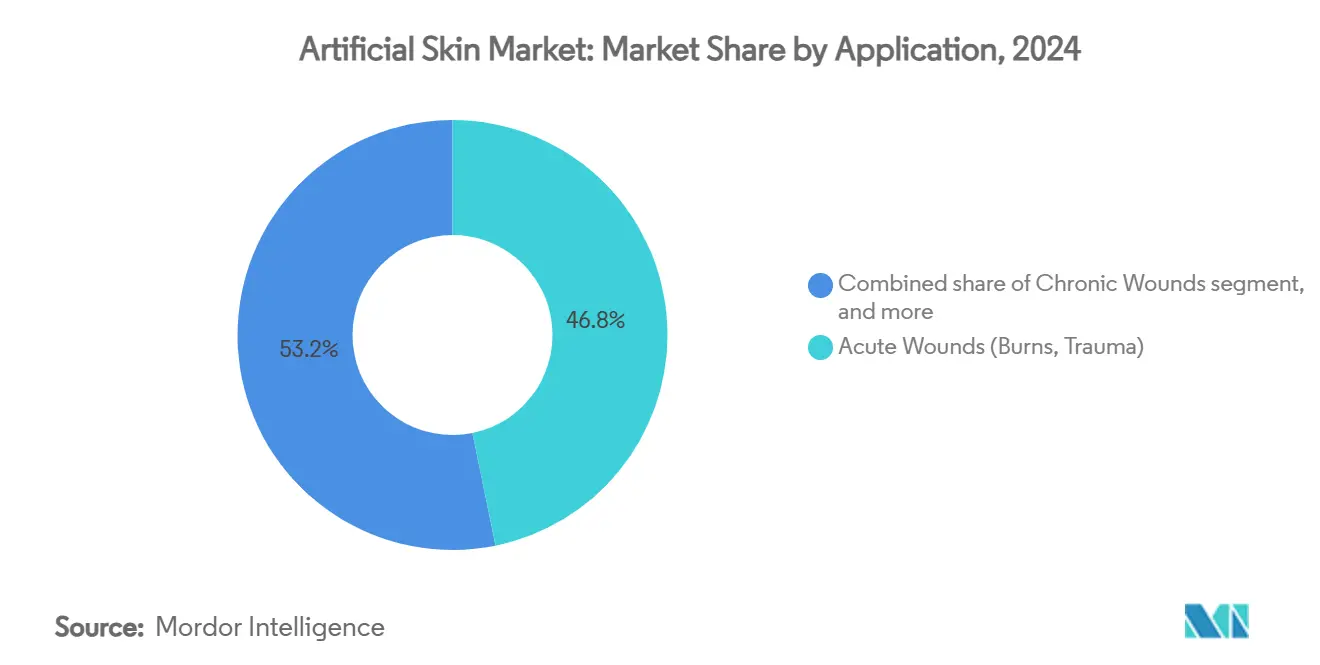
Note: Segment shares of all individual segments available upon report purchase
By End-User: Hospitals Retain Core Volume While Outpatient Centers Rise
Hospitals delivered 62.45% of product purchases in 2024 because complex burns and large chronic ulcers still require multidisciplinary management, negative-pressure devices and graft operating suites. However, ambulatory surgical centers (ASCs) register a 9.65% CAGR as insurers push lower-acuity cases to cost-efficient settings. ASCs embrace spray-on autologous cell solutions that reduce procedure time and enable same-day discharge, attractive to both patients and payers. Specialized wound-care centers, often physician-owned, form a bridge by handling advanced ulcers that exceed home-health capability yet do not merit full hospital admission.
CMS reimbursement caps currently apply only to inpatient episodes, but future rulemaking may equalize outpatient payments and narrow ASC margins. Suppliers diversify their catalogs with unit-dose packaging and shelf-stable hydrogels to meet ASC workflow needs while keeping hospital bulk kits for operating rooms. This channel bifurcation shapes go-to-market strategy across the artificial skin industry.
Geography Analysis
North America accounted for 40.54% of 2024 global revenue thanks to robust trauma care infrastructure, generous reimbursement and a dense network of burn centers. The United States drives regional dominance with early FDA clearances such as RECELL GO mini, which treats wounds up to 480 cm² and reduces autograft requirements. Canada and Mexico trail but grow steadily as universal healthcare systems invest in modern wound-care pathways. Upcoming payer reforms may compress unit prices yet also stimulate volume through broadened indications. The artificial skin market size for North America is forecast to advance in single digits as innovators substitute costly living-cell grafts with cheaper bio-hybrids that retain outcome parity.
Asia-Pacific is projected to post a 7.54% CAGR to 2030, the fastest worldwide. Rapid urbanization, aging populations and rising diabetes prevalence underpin high procedure volumes, while governments expand insurance coverage. China pushes domestic bioprinting ventures under Made-in-China policy incentives, seeking self-sufficiency and export potential. Japan maintains sophisticated tissue-engineering regulations that accelerate approval of proven constructs, helping early adoption. India and Indonesia still face affordability hurdles, but public-private partnerships aim to supply subsidized grafts for trauma centers along major highway corridors. As scale rises, localized production will trim logistics costs and support price-sensitive markets, reinforcing APAC as a strategic growth engine within the artificial skin market.
Europe holds significant share via mature healthcare systems and coordinated trauma networks. Germany and France prioritize evidence-based purchasing, favoring products backed by randomized trials. The region’s strict Medical Device Regulation imposes high documentation but assures clinicians of product quality, sustaining steady uptake. Eastern European nations leverage cohesion funds to upgrade burn units, creating incremental demand. Middle East & Africa and South America remain nascent yet promising. Wealthier Gulf states import premium constructs for complex cosmetic surgeries, whereas Brazil integrates grafts into its Unified Health System for accident victims. Exchange-rate volatility and limited reimbursement slow broader penetration, though humanitarian aid projects occasionally deploy composite grafts in conflict zones where burn injuries are prevalent.
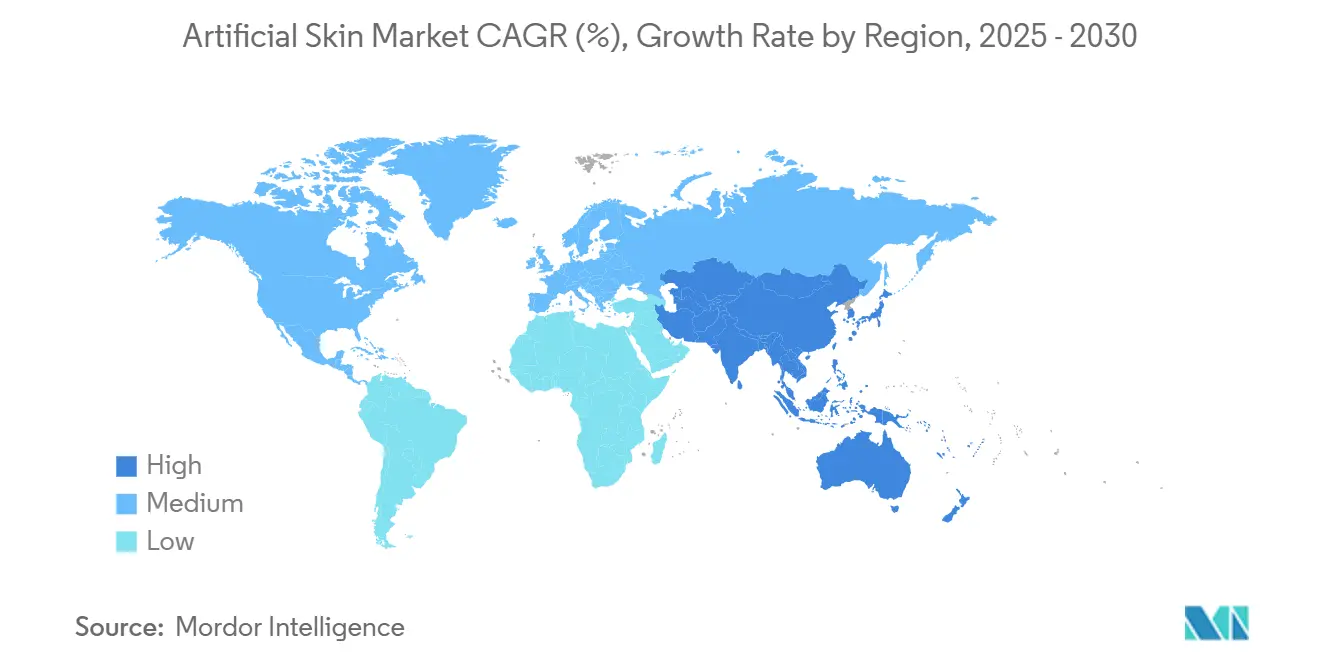
Competitive Landscape
The artificial skin market exhibits moderate fragmentation with a combined top-five share near 35%, implying vigorous competition and room for new entrants. 3M, Smith+Nephew and Integra LifeSciences dominate traditional collagen matrices, leveraging global sales forces and hospital contracts. Smith+Nephew’s USD 660 million takeover of Osiris Therapeutics augmented its biologics line and improved cross-selling to orthopedic trauma customers. AVITA Medical focuses on spray-on autologous solutions and recently broadened its addressable pool with Cohealyx, a collagen scaffold that complements its RECELL platform, illustrating a convergence strategy that unites cell therapy and passive matrices.
Start-ups such as Electrospinning Company, Cutiss and Stratasys spinouts pursue high-resolution bioprinting and hybrid polymers. Venture investment targets automated microfluidic bioreactors that culture skin equivalents at scale, aiming to cut cost per square centimeter below USD 85 to stay profitable under impending CMS flat fees. Strategic alliances are increasingly cross-sectoral; Geistlich Pharma’s partnership with StimLabs combines dental-bone expertise with regenerative dermal platforms, exploiting shared collagen sourcing and regulatory know-how. Digital health integration is another battleground: firms embed near-field communication sensors into graft dressings to transmit pH and temperature to cloud apps, enhancing clinician oversight and supporting value-based reimbursement.
Manufacturing capacity and supply-chain resilience now influence bidding success more than proprietary biology alone. Firms are localizing collagen extraction and freeze-drying lines to bypass geopolitical trade risks and to capture sustainability credits in tender evaluations. Simultaneously, academic-industry consortia pool patent estates to accelerate composite hydrogel development, shortening time to clinical proof. Market observers expect further consolidation as reimbursement compression pressures sub-scale innovators to partner or exit, likely lifting the artificial skin market toward a more oligopolistic structure over the next five years.
Artificial Skin Industry Leaders
-
Integra Lifesciences Corporation
-
Smith & Nephew Plc
-
Medtronic
-
Molnycke Health Care AB
-
Baxter International Inc.
- *Disclaimer: Major Players sorted in no particular order
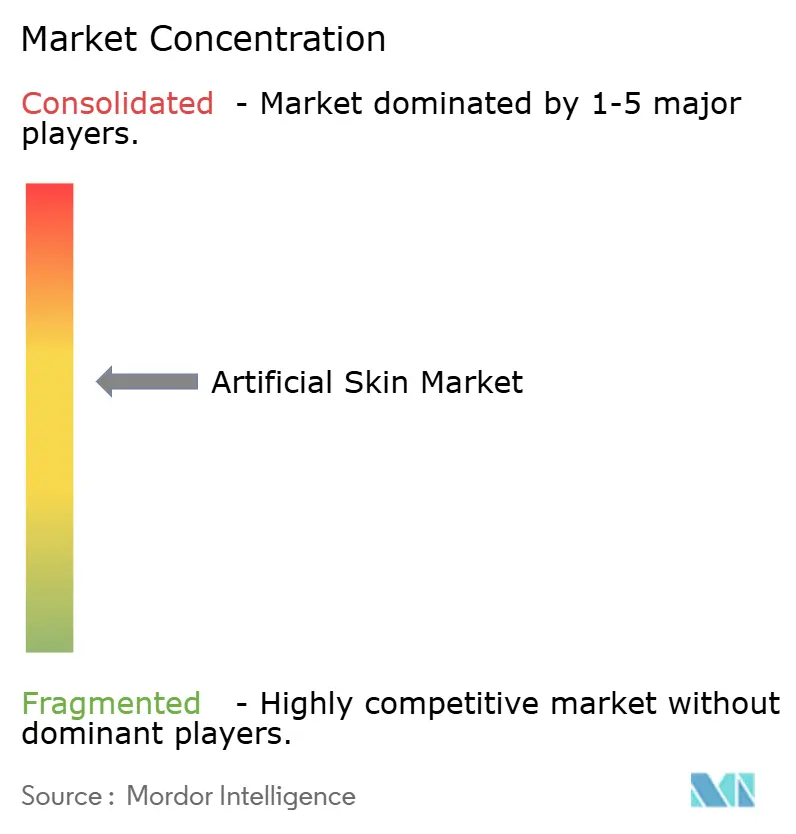


Recent Industry Developments
- May 2025: Faircraft acquired VitroLabs assets to expand leadership in lab-grown leather, underscoring cross-industry applications of artificial skin technologies.
- April 2025: Caltech unveiled the iCares smart bandage that monitors biomarkers and uses machine learning to advise dressing changes.
- March 2025: Aalto University and University of Bayreuth developed self-healing hydrogels that restore 80-90% integrity within four hours, promising next-gen graft resilience.
- December 2024: AVITA Medical received FDA approval for RECELL GO mini, enabling treatment of smaller wounds up to 480 cm² and broadening surgeon adoption.
- December 2024: AVITA Medical secured FDA 510(k) clearance for Cohealyx, a collagen-based dermal matrix set to triple the firm’s burn-care opportunity.
- December 2024: The FDA approved Symvess, the first acellular tissue-engineered vessel for extremity trauma, produced by Humacyte Global.
Global Artificial Skin Market Report Scope
As per the scope of the report, artificial skin is a synthetic substitute for human skin that can induce the regeneration of the skin. The skin is the largest organ in the human body and comprises two layers, namely, the epidermis and dermis. Severe burns and wounds make the body vulnerable to infections and impair the healing process. Artificial skin helps to overcome this obstacle and quickens the healing of wounds and burns. Artificial skin does not contain any immunogenic cells, hence not rejected by the body. The artificial skin market is segmented by Product type (Permanent, Temporary, and Composite), by Replacement Area (Dermal, Epidermal, and Composed) by Material (Natural, Synthetic and Both), By Application (Acute Wounds, Chronic Wounds, and Others), By End User ( Hospitals, Burn Care Centers and Others), and (North America, Europe, Asia-Pacific, Middle East, and Africa, and South America). The market report also covers the estimated market sizes and trends for 17 different countries across major regions, globally. The report offers the value (in USD million) for the above segments.
| Permanent |
| Temporary |
| Composite / Hybrid |
| Dermal |
| Epidermal |
| Full-Thickness (Composite) |
| Natural (Collagen, Fibrin, Etc.) |
| Synthetic (PGA, PCL, PU, Etc.) |
| Bio-Hybrid |
| Acute Wounds (Burns, Trauma) |
| Chronic Wounds (Diabetic Ulcers, Pressure Ulcers) |
| Cosmetic & Aesthetic Procedures |
| Hospitals |
| Specialised Burn & Wound-Care Centres |
| Ambulatory Surgical Centres |
| North America | United States |
| Canada | |
| Mexico | |
| Europe | Germany |
| United Kingdom | |
| France | |
| Italy | |
| Spain | |
| Rest of Europe | |
| Asia-Pacific | China |
| Japan | |
| India | |
| Australia | |
| South Korea | |
| Rest of Asia-Pacific | |
| Middle East & Africa | GCC |
| South Africa | |
| Rest of Middle East & Africa | |
| South America | Brazil |
| Argentina | |
| Rest of South America |
| By Product Type | Permanent | |
| Temporary | ||
| Composite / Hybrid | ||
| By Replacement Area | Dermal | |
| Epidermal | ||
| Full-Thickness (Composite) | ||
| By Material | Natural (Collagen, Fibrin, Etc.) | |
| Synthetic (PGA, PCL, PU, Etc.) | ||
| Bio-Hybrid | ||
| By Application | Acute Wounds (Burns, Trauma) | |
| Chronic Wounds (Diabetic Ulcers, Pressure Ulcers) | ||
| Cosmetic & Aesthetic Procedures | ||
| By End-User | Hospitals | |
| Specialised Burn & Wound-Care Centres | ||
| Ambulatory Surgical Centres | ||
| Geography | North America | United States |
| Canada | ||
| Mexico | ||
| Europe | Germany | |
| United Kingdom | ||
| France | ||
| Italy | ||
| Spain | ||
| Rest of Europe | ||
| Asia-Pacific | China | |
| Japan | ||
| India | ||
| Australia | ||
| South Korea | ||
| Rest of Asia-Pacific | ||
| Middle East & Africa | GCC | |
| South Africa | ||
| Rest of Middle East & Africa | ||
| South America | Brazil | |
| Argentina | ||
| Rest of South America | ||


Key Questions Answered in the Report
What is the current value of the artificial skin market?
The market stands at USD 3.21 billion in 2025 and is expected to reach USD 4.32 billion by 2030.
Which region is growing the fastest in artificial skin adoption?
Asia-Pacific is projected to grow at a 7.54% CAGR through 2030 owing to aging demographics and expanding healthcare infrastructure.
Which application area leads demand for artificial skin?
Acute wound treatment, including burns and trauma, generated 46.87% of 2024 revenue.
What product type is expanding most quickly?
Composite and hybrid constructs are forecast to register an 8.65% CAGR up to 2030.
How are reimbursement changes affecting manufacturers?
Proposed U.S. flat-rate payments incentivize cost-efficient production and may spur consolidation among smaller companies.
Which material platform currently dominates sales?
Natural collagen- and fibrin-based matrices held 52.45% of 2024 revenue, though bio-hybrids are gaining momentum.
Page last updated on:
